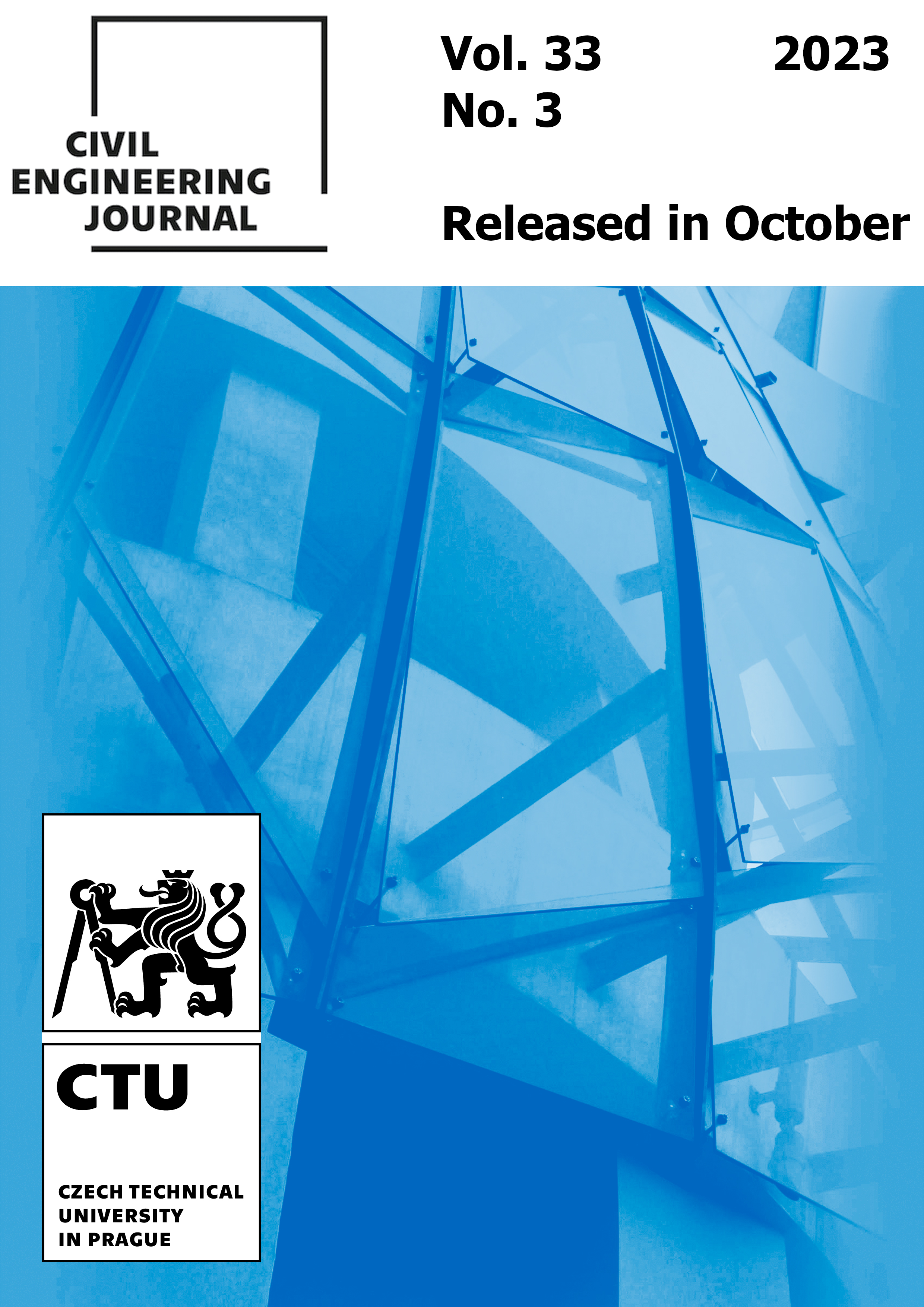EMPIRICAL VULNERABILITY ANALYSIS OF RAILWAY BRIDGE SEISMIC DAMAGE BASED ON 2022 MENYUAN EARTHQUAKE
DOI:
https://doi.org/10.14311/CEJ.2023.03.0028Keywords:
railway bridge, empirical vulnerability, seismic damage prediction, ordinal logistic regressionAbstract
A 6.9 magnitude earthquake at a depth of 10 km struck Menyuan County, Haibei Prefecture, Qinghai Province, China, on January 8, 2022. This earthquake damaged some railway bridges on the Lanzhou-Xinjiang Passenger Dedicated Line. This study combines relevant historical earthquake damage experience, considers the effects of earthquake intensity, site soil classification, superstructure type, foundation failure factor, number of spans, and total bridge length, and develops empirical formulas for seismic damage prediction of railway bridges using ordinal logistic regression model in SPSS software. The seismic damage matrix, as were the anticipated multi-intensity mean damage index and the empirical vulnerability curve based on the two-parameter lognormal distribution function, were generated on this basis. According to the conclusions, although the suggested particular equations and vulnerability curves do not apply to the remainder of the region owing to geographical uniqueness, the technical approach is valid. It may be used as a reference for seismic damage prediction and vulnerability evaluation in other regions. The empirical vulnerability analysis based on the earthquake damage prediction matrix derived from the regression analysis can provide reasonable and fast forecasts before the next earthquake.
Downloads
References
Wang DS,Feng QM. Prediction Method of Bridge Earthquake Damage [J]. Journal of Natural Disasters, 2001(03): 113-118.
Keizaburo Kubo, Zhang SS. Earthquake Damage Prediction of Bridges [J]. World Earthquake Engineering, 1984(05): 8-11.
Zhu MZ. Practical Methods of Earthquake Damage Prediction for Highway Bridges [J]. Journal of Tongji University (Natural Science Edition), 1994(03): 279-283.
Wang TW, Yang CH. Earthquake Damage Prediction and Seismic Reinforcement of Railway Bridges [J]. Railway Construction, 1991(08): 4-9.
Kobayashi HIROSHI, etc. The method of deducing the degree of disaster of the road and bridge in Okeo during the great earthquake [J]. Technical Information on Civil Engineering, 2005, 47(12): 48-53.
Kazuhiro NAGAYA, Shojiro KATAOKA, Takaaki KUSAKABE, etc. A Research on Immediate Damage Estimation Technology to Improve Crisis Management for MEGA-Earthquakes [J]. Journal of Japan Society of Civil Engineers, Ser. A1 (Structural Engineering & Earthquake Engineering), 2017, 72(4): 966-974.
Omichi KAZUHO, Shojiro KATAOKA, etc. Verification and Improvement of Structure Damage Estimation Method for Highway Bridges Based on Damage Data of the 2016 Kumamoto Earthquake [J]. Journal of Japan Society of Civil Engineers, Ser. A1 (Structural Engineering & Earthquake Engineering), 2020, 76(4): 765- 773.
Murano YOSHITAKA, NOGAMI YUTA, MIYAMOTO TAKEFUMI. Simple Method to Predict Outline of Seismic Damages of Railway Structures and Running Vehicles [J]. Journal of Japan Society of Civil Engineers, Ser. A, 2010, 66(3): 535-546.
Naoto Iwata, Tojun Sakai, Tojun Yamamoto, etc. Earthquake Countermeasures for Railway Stations in Railway Systems Development of a Railway Earthquake Damage Estimation Information Distribution System for Quick Resumption of Operations [J]. Railway Architecture News, 2020, 77(2): 30-33.
Zong L, Wang YQ, Yang SN et al. Research on Earthquake Damage Assessment Model of Highway and Bridge in China Based on HAZUS Platform [J]. Journal of Civil Engineering, 2014, 47(S1):263-268.
Hu Y. Earthquake Engineering [M]. Beijing: Seismological Press, 2006:354-400.
Cai LW, HUANG Yong, HE Jing et al. Transportation System Damage from the 2022 M6.9 Menyuan Earthquake in Qinghai Province and its implications[J]. Earthquake Engineering and Engineering Vibration, 2022. 42(04): 8-16.
Lin B. Multiple Linear Regression Analysis and its Application [J]. China Science and Technology Information, 2010(09): 60-61.
Du HM, Li W. Analysis of Talent Flow Based on SPSS Multiple Linear Regressions [J]. Software, 2017. 38(10): 149-151.
Wang DH et al. Multivariate Statistical Analysis and SPSS Application [M]. Shanghai: East China University of Science and Technology Press Co., LTD, 2018:150-220. [16] Gao WD. Discrimination and Classification of Expansive Soil Based on Logistic Regression Model [J]. Journal of Yangtze River Scientific Research Institute, 2020. 37(06): 153-155.
H. Hwang, Liu JB. Vulnerability Analysis of Reinforced Concrete Bridge Structures under Earthquake [J]. Journal of Civil Engineering, 2004(06): 47-51.
Chen LB, Zhen KF et al. Vulnerability Analysis of Bridges in Wenchuan Earthquake [J]. Journal of Southwest-Jiao tong University, 2012. 47(04): 558-566.
Li SQ, Yu TL, Zhang M. Comparative analysis of vulnerability of typical structures in different intensities [J]. Journal of South China University of Technology (Natural Science Edition), 2020. 48(03): 67-75.
GB/T 17742-2008 China Intensity Table[S].Beijing: Standards Press of China, 2008.
Hubert, W.L. On the Kolmogorov-Smirnov Test for Normality with Mean and Variance Unknown [J]. Journal of the American Statistical Association, 2012. 62(318).
Downloads
Published
Issue
Section
License
Copyright (c) 2023 Author

This work is licensed under a Creative Commons Attribution-NonCommercial 4.0 International License.
Authors who publish with this journal agree to the following terms:
- Authors retain copyright and grant the journal right of first publication with the work simultaneously licensed under a Creative Commons Attribution License that allows others to share the work with an acknowledgement of the work's authorship and initial publication in this journal.
- Authors are able to enter into separate, additional contractual arrangements for the non-exclusive distribution of the journal's published version of the work (e.g., post it to an institutional repository or publish it in a book), with an acknowledgement of its initial publication in this journal.
- Authors are permitted and encouraged to post their work online (e.g., in institutional repositories or on their website) prior to and during the submission process, as it can lead to productive exchanges, as well as earlier and greater citation of published work (See The Effect of Open Access).
How to Cite
Accepted 2023-10-19
Published 2023-10-30











